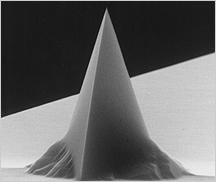
All SPM probes of the Pointprobe® series are made from monolithic silicon which is highly doped to dissipate static charge. They are chemically inert and offer a high mechanical Q-factor for high sensitivity. The AFM tip is shaped like a polygon based pyramid.
Additionally, this AFM probe offers an excellent tip radius of curvature.
This AFM probe features alignment grooves on the back side of the holder chip.
